Intel NUC 12 Pro Wall Street Canyon Kits Review: Alder Lake in UCFF Avatar
by Ganesh T S on January 26, 2023 11:30 AM ESTGPU Performance: Synthetic Benchmarks
Intel did not make significant changes in the integrated GPU when moving from Tiger Lake to Alder Lake. Process maturity has allowed it to clock the iGPU a bit higher, but the number of EUs remains the same as in the previous generation. GPU performance evaluation typically involved gaming workloads, and for select PCs, GPU compute. Prior to that, a look at the capabilities of the GPU in the NUC 12 Pro kits is warranted.
The Intel Iris Xe Graphics in the NUC 12 Pro kits is an integrated GPU based on a reworked scalable architecture. The performance of the iGPU is miles ahead of previous iGPUs from both Intel and AMD, as the benchmarks below show.
GFXBench
The DirectX 12-based GFXBench tests from Kishonti are cross-platform, and available all the way down to smartphones. As such, they are not very taxing for discrete GPUs and modern integrated GPUs. We processed the offscreen versions of the 'Aztec Ruins' benchmark.
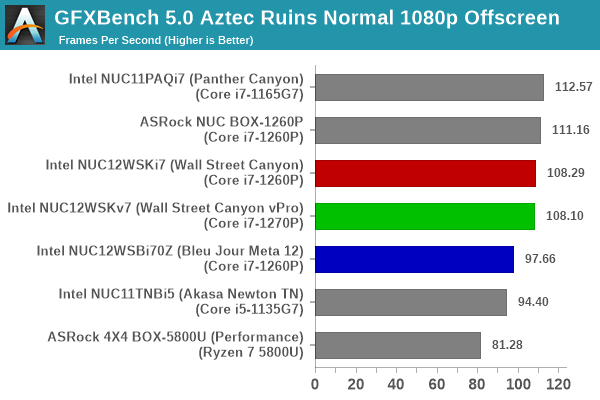
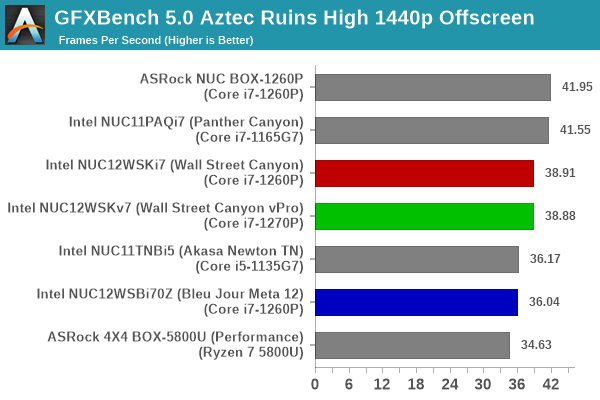
Panther Canyon has a slightly higher PL2 (67W) that gives it a bit of an edge. However, the power budget allocation in the ASRock Industrial unit to the iGPU seems to be better than the one in the NUC 12 Pro units, and that translates to the NUC 12 Pro kits coming in the middle of the pack. However, the scenario changes when offscreen considerations are dropped.
UL 3DMark
Four different workload sets were processed in 3DMark - Fire Strike, Time Spy, Night Raid, and Wild Life. The results below consistently show the actively-cooled NUC 12 Pro kits performing much better than the other systems in the mix. A combination of faster clocks and higher power budgets appear to be the reason behind this.
3DMark Fire Strike
The Fire Strike benchmark has three workloads. The base version is meant for high-performance gaming PCs. It uses DirectX 11 (feature level 11) to render frames at 1920 x 1080. The Extreme version targets 1440p gaming requirements, while the Ultra version targets 4K gaming system, and renders at 3840 x 2160. The graph below presents the overall score for the Fire Strike Extreme and Fire Strike Ultra benchmark across all the systems that are being compared.
| UL 3DMark - Fire Strike Workloads | |||
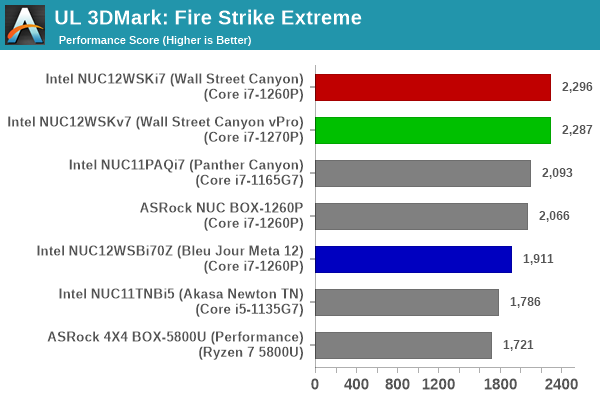
3DMark Time Spy
The Time Spy workload has two levels with different complexities. Both use DirectX 12 (feature level 11). However, the plain version targets high-performance gaming PCs with a 2560 x 1440 render resolution, while the Extreme version renders at 3840 x 2160 resolution. The graphs below present both numbers for all the systems that are being compared in this review.
| UL 3DMark - Time Spy Workloads | |||
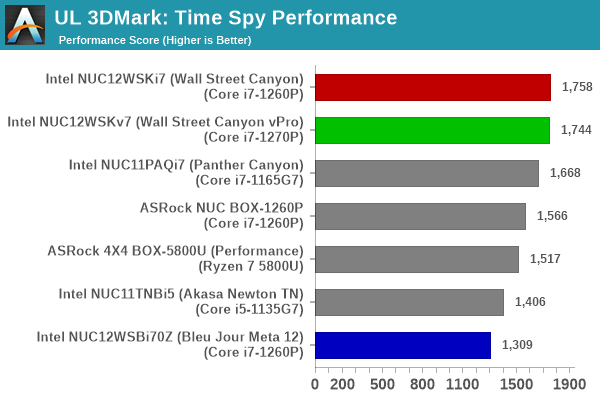
3DMark Wild Life
The Wild Life workload was initially introduced as a cross-platform GPU benchmark in 2020. It renders at a 2560 x 1440 resolution using Vulkan 1.1 APIs on Windows. It is a relatively short-running test, reflective of mobile GPU usage. In mid-2021, UL released the Wild Life Extreme workload that was a more demanding version that renders at 3840 x 2160 and runs for a much longer duration reflective of typical desktop gaming usage.
| UL 3DMark - Wild Life Workloads | |||

3DMark Night Raid
The Night Raid workload is a DirectX 12 benchmark test. It is less demanding than Time Spy, and is optimized for integrated graphics. The graph below presents the overall score in this workload for different system configurations.
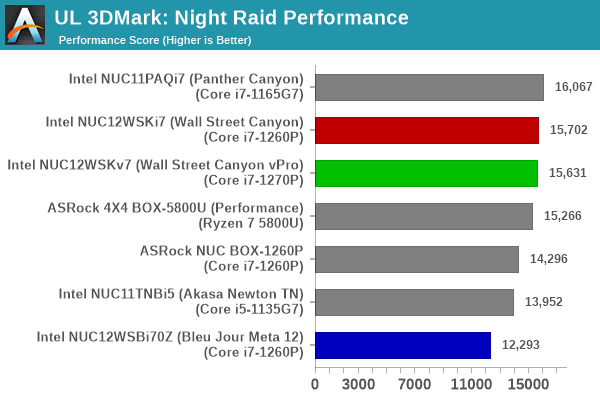











25 Comments
View All Comments
dontlistentome - Thursday, January 26, 2023 - link
There's quite a few discounts floating around for the 11th gen at the moment, so probably a better bet for many users.As ever Intel send the i7 - i've been looking at the i3-1220p version - effectively the i5-1235u - 2x P plus 8x E cores should be better thermals, still great peak performance and should live nicely in an Akasa Turing case fanless. Only frustration is there onlyseems to be about £40 between the i3 and i5.
I think if you're using these as a desktop the Dell/HP/Lenovo micro desktops are a better bet - bigger for better cooling so should be quieter.
1_rick - Thursday, January 26, 2023 - link
I've been using a Beelink SEI12 for a couple of weeks, the 1235U version, and it's pretty impressive, all things considered. I did notice that out of the box it will tend to be power limited to keep the fan noise reasonable: Prime95 settles in very quickly to a speed of around 2500MHz for the P cores and 100MHz slower for the E cores. But if you're doing anything that isn't that computationally intensive, it feels plenty snappy, especially compared to, say, a 5yo Dell Latitude (even when that was new). Surprisingly, it'll even play Minecraft (unmodded) pretty well.dontlistentome - Friday, January 27, 2023 - link
Nice. I've got an i7-1260p thinkpad from work and it's a furnace that thermally throttles constantly. I don't need 4 fat cores for a box that will be running pretty gentle server services (basic file-sharing, MySQL for Kodi, Roon, Home Assistant etc) two can handle the peaks with the E cores humming away in the background. I may just go for an 8 E core i3-300N box if they appear soon.nandnandnand - Friday, January 27, 2023 - link
It might be worth it to go to 1215U or 1235U instead depending on the use case. Alder Lake-N drops a memory channel, supports only 16 GB memory, and drops many of the PCIe lanes. If the specs on ARK are accurate. Even the weird Intel Processor U300 might be better.diamondsw - Thursday, January 26, 2023 - link
Given the recent introduction of the M2 Mac Mini, it would be very interesting to see how Intel's small form factor integrated system compares to Apple's. We haven't seen much head-to-head between Intel and Apple Silicon in a while, and a lot has changed (more for Intel than Apple). I imagine performance and power consumption would be closer these days.timecop1818 - Thursday, January 26, 2023 - link
What do you need to compare? The NUC runs a real OS and can actually be used for serious work, while the apple offering can only scroll Facebook and Instagram but at 120HzGrabo - Thursday, January 26, 2023 - link
While "a real OS" and "serious work" makes your comment harder to take seriously you have a point in that the Nuc can run any OS (except perhaps macOS) whereas the Macmini is closely associated with MacOS (I hope Asahi gets to where it wants to go and enables Linux on Apple's arm implementation). I have little doubt the Macmini is the more power efficient machine, especially the M2. (Am currently writing this on a NUC12WSHi5. It works pretty well but don't force it to do 120Hz and play youtube videos. I kind of wish more reviewers would mention the NUC fan. Even at "quiet" it behaves like the small fan that it is, sudden jumps to 100% fan noise as the CPU or GPU load suddenly increases)Kuhar - Friday, January 27, 2023 - link
I agree with you 100% - both on comment about Apple and NUC. The problem with those NUC fans is IMHO their coolers arent big enough (not enough mass - same problem with most laptops) so the fan starts every time even for relatively small temperature increase. And the fan curve isnt to my liking aswell - i would prefer if fan would spin constantly with lower RPMs than to start/stop all the time.max - Friday, February 3, 2023 - link
Because it'll be interesting. That's why. Mabye not for the wintel-fanboys like You, which need couple of years to grow up. MacOS i very powerful OS, and Apple hardware is the best in its class. I agree, maybye not for kids like you, so don't bother. Nobody cares what is your opinion.erotomania - Thursday, January 26, 2023 - link
Thanks Ganesh!$167 for a 100 MHz clock bump (1260P -> 1270P). Anything else included with that? I looked and could not find.